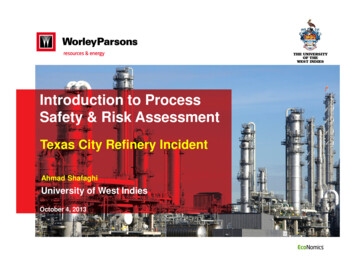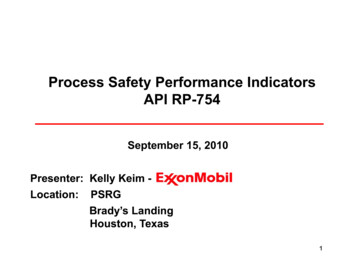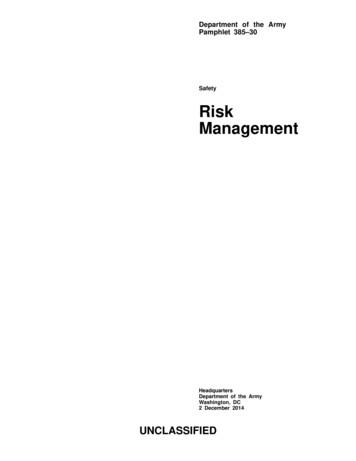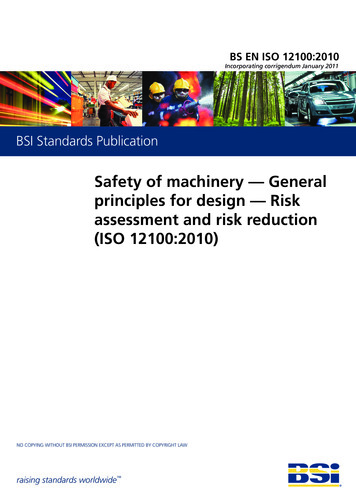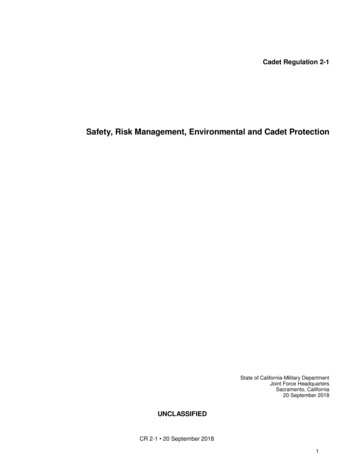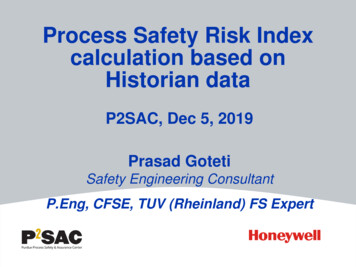
Transcription
Process Safety Risk Indexcalculation based onHistorian dataP2SAC, Dec 5, 2019Prasad GotetiSafety Engineering ConsultantP.Eng, CFSE, TUV (Rheinland) FS Expert
Abstract Introduce API RP 754 and ISA 61511 Briefly walk though the concepts of KPIs, define and explainLeading and Lagging indicators, Define Risk Index (Short term and Long term) Demonstrate by example how these indices are calculatedbased on “Design” data and “Real” (Historian) data2HONEYWELL - CONFIDENTIAL
API RP 754 API RP 754 is titled “Process Safety Performance Indicators forthe Refining and petrochemical Industries”, the second edition ofwhich came out in April 2016. With reference to Safety life Cycle of ISA 61511, this RP isapplicable during the Operation and Maintenance phase. The purpose of the Recommended Practice (RP) is to identifyleading and lagging indicators in the refinery and petrochemicalindustries whether for public reporting or for use at individualfacilities including methods for the development of KeyPerformance Indicators (KPI). As a framework for measuring activity, status or performance, theRP classifies Process Safety Indicators (PSI) into four tiers ofleading and lagging indicators. Tiers 1 and 2 are suitable for publicreporting while Tier 3 and 4 are meant for internal use at individualsites.3HONEYWELL - CONFIDENTIAL
API RP 7544HONEYWELL - CONFIDENTIAL
Key Performance Indicators (KPI)5HONEYWELL - CONFIDENTIAL
Plant Health % – Opposite of Risk IndexHoneywell Confidential - 2019 by Honeywell International Inc. All rights reserved.6
The Safety Life Cycle as defined in ISA61511SIL Verification calcs to Meet Target SILsConceptual ProcessDesignPerform Process HazardAnalysis & Risk AssessmentApply non-SISprotection layers to preventidentified hazards or reduceriskDevelop SafetyRequirements SpecificationEstablish Operation &Maintenance ProceduresPerform SIS ConceptualDesign, and verify it meetsthe SRSPre-startup Safety Review(Assessment)Perform SIS Design DetailNoSIS Required?YesSIS InstallationCommissioning and PreStartup Acceptance TestSIS Startup Operation,Maintenance PeriodicFunctional testingModify orDecommission SIS ?DecommissionDefine Target SILSIS DecommissioningAnalysis phase7ImplementationphaseOperation phaseHONEYWELL - CONFIDENTIALStill meeting Targets ?
HazopPIC-1 SP 3 ATMPSV SP 4.0 ATMUpstreamPressure 5 ATMMAWP of V-1 5 ATM Node: Vessel V-1 Guideword: HIGH PRESSURE Consequence: High Pressure, possible vessel rupture & fire Cause of failure: PIC-1 (BPCS), Control valve (PCV-1) stuck open Existing Safeguards : PSV-1 Additional Protection Layers : No recommendation8HONEYWELL - CONFIDENTIAL
Risk Reduction (with PSV only)From the HAZOP risk matrix for this Process, with PSV as safeguard :1. Frequency of Initiating Event (IE) – (L 3) (L 5 without any safeguards)2. Severity – Single fatality (S 2)3. Risk (with PSV as safeguard) (Box 5) (Base Risk without PSV, Box 3)LOPA TMEL (Single Fatality) :1E-05 per year9HONEYWELL - CONFIDENTIAL
Add a SIF-1 (SIL2, RRF 100) High Pressure Trip PSHH-4275 added- Shuts off XZV-4275 when PZT-4275 detects Pressure in Vessel V-1 3.75 ATM- XZV-4275 will be a De-energized To Trip (DTT) Fail Close valve, Open when Pressureis less than 3.75 ATM10HONEYWELL - CONFIDENTIAL
Risk Reduction (with PSV and SIF)From the HAZOP risk matrix for this Process, with the Two safeguards :1. Frequency of Initiating Event (IE) – (L 1)2. Severity – (S 2)3. Risk (with Two safeguards) (Box 7) (Acceptable Risk level)LOPA TMEL (Single Fatality) :1E-05 per year11HONEYWELL - CONFIDENTIAL
What if PZT-4275 Transmitter is Bypassed ?PZT-4275PSHH-1ESDV-1If PZT-4275 is bypassed, then there is no active SIF12HONEYWELL - CONFIDENTIAL
Risk Reduction (with SIF in Bypass)From the HAZOP risk matrix for this Process, if SIF is Bypassed:1. Frequency of Initiating Event (IE) – (L 3)2. Severity – Single fatality (S 2)3. Risk (with only PSV as safeguard) (Box 5)LOPA TMEL (Single Fatality) :1E-05 per year13HONEYWELL - CONFIDENTIAL
When SIF Not BypassedIE - PIC-1 fails : Once every 10 years (0.1)System normalPSHH-1 fails : Once every100 demands (PFD 0.01)PSV fails : Onceevery 100demands (PFD 0.01)Probable Likelihood of Explosion PL(Loss Of Containment) x P(Ignition) 0.1 x 0.01 x 0.01 x 1 1E-05per year TMEL14HONEYWELL - CONFIDENTIALVessel V-1 ruptures and findsa source of ignition (100%)
When SIF BypassedIE - PIC-1 fails : Once every 10 years (0.1)System normalPSHH-1 fails : PFD 1 (doesnot exist)PSV fails : Onceevery 100demands (PFD 0.01)Probable Likelihood of Explosion PL(Loss Of Containment) x P(Ignition) 0.1 x 1 x 0.01 x 1 1E-0315per year TMELHONEYWELL - CONFIDENTIALVessel V-1 ruptures and finds asource of ignition (assume100%, ie 1)
Process Risk Index (Tier 2 KPI) Process Risk Index (PRI) is one number which indicates theProcess Risk profile of a Process Plant during a small period(Short term) or over a period of time (Long term) Short Term (ST) PRI is for a period of One shift or One day.This is for the Plant Operations Manager to get an idea how theirProcess plant is doing based SIFs that have been bypassed Long Term (LT) PRI is for a period of a few months and above.This is for the senior management (and plant management) toknow how the Process plant has been doing in the long termbased on SIF demands, SIF bypass and On Time testing ofSIF components16HONEYWELL - CONFIDENTIAL
Short Term Risk IndexAssumptions for ST Risk Index equations: “Safety” is the driver for this hazardous event (not Commercial andEnvironment) PFDactual of SIF and non-SIF IPL is the same as PFD per design The SIF has 1oo1 input voting All other IPLs are working per designVariable which effects Short Term (ST) Risk Index SIF “Time in Bypass” over the Short term period.This data is collected from the Historian over the specified Shortterm.17HONEYWELL - CONFIDENTIAL
Design and Historian data compared – Short TermHistorian18HONEYWELL - CONFIDENTIALSIF Time in Bypass
Short Term Risk Index (One scenario)Designed ST Safety Risk TMEL (for safety) x Safety Severity(the assumption here is that with the designed IPLs, the TMEL hasbeen met)Actual ST Safety Risk IEF x [(PFD of non-SIF IPL x SIF PFD) x(Time SIF NOT in Bypass/SST) (PFD of non-SIF IPL) x (Time SIFin Bypass/SST )] x Safety Severitywhere :IEF Initiating Event FrequencySST Short Sample TimeST Safety Risk Index [Log of (Designed Safety Risk/Actual SafetyRisk) / Log of Designed Safety Risk)]*10019HONEYWELL - CONFIDENTIAL
ST Risk Indication calculation (One scenario)In our example, if SIF-1 input (PZT-4275) in 24 Hours period : bypassed for 8 Hours SIF design PFD 4.94E-03Example for Scenario 1 for SAFETY only :GivenTMEL (safety)GivenSIGivenSST24 HrsConsiderIEF0.1 (once in 10 years)Designnon-SIF IPL PFDDesignSIF PFDFrom HistorianSIF input BYP time HrsDesigned RiskLog of Designed Risk201.00E-05 (once in 100,000 years)1 (one fatality)1.00E-05-5Actual Risk3.37E-04(Designed/Actual) Risk0.029706Log of (Designed/Actual)-1.52715ST Safety RI %30.54297HONEYWELL - CONFIDENTIAL0.010.004948
Risk Reduction (Based on ST Risk Index)From the HAZOP risk matrix for this Process :1. Short Term sample time : 24 Hours2. SIF Bypass time : 8 hours3. Calculated Safety ST RI 30% (Approx)LOPA TMEL (Single Fatality) :1E-05 per year21HONEYWELL - CONFIDENTIAL
Short Term Risk Index (Multiple scenarios)Designed ST Safety Risk (Multiple) (TMEL (for safety) x Safety Severity)(the assumption here is that with the designed IPLs, the TMEL has been met forall scenarios)Actual ST Safety Risk (Multiple) (IEF x [(PFD of non-SIF IPL x SIF PFD) x (Time SIF NOT in Bypass/SST) (PFD of non-SIF IPL) x (Time SIF in Bypass/SST )] x Safety Severity)where :IEF Initiating Event FrequencySST Short Sample TimeST Safety Risk Index (Multiple) [Log of (Designed Safety Risk(Multiple)/Actual Safety Risk(Multiple)) / Log of Designed SafetyRisk(Multiple))]*100Worst actor of ST Safety Risk Index Highest ST Safety Risk Index (ONEscenario)22HONEYWELL - CONFIDENTIAL
Long Term Risk IndexAssumptions for LT Risk Index equations: “Safety” is the driver for this haz. event (not Commercial and Environment) PFDactual of SIF and non-SIF IPL may not be the same as PFD per design The SIF input has 1oo1 input votingVariable which effects Long Term (LT) Risk Index SIF demand rate. If this is greater than the assumed IEF, then SIF demand ratewill be considered in the “Actual LT Safety Risk” equation SIF “Time in Bypass” over the Long Term period IPLs On time testing. If this is different than what was considered during design,then this will effect the PFDactual of the IPLsThis data is collected from the Historian and plant CMMS (ComputerMaintenance Management System) over the specified Long term.23HONEYWELL - CONFIDENTIAL
Design and Historian data compared – Long TermHistorianCMMS24HONEYWELL - CONFIDENTIALSIF Time in BypassSIF DemandsSIF OnTime testing
Long Term Risk Index (One Scenario)Designed Long Term Safety Risk TMEL (for safety) x SafetySeverity(the assumption here is that with the designed safeguards,TMEL hasbeen met)Actual LT Safety Risk SIF demands x [(PFDactual of non-SIF IPL xSIF PFDactual) x (Time SIF NOT in Bypass/LST) (PFDactual ofnon-SIF IPL) x (Time SIF in Bypass/LST )] x Safety Severitywhere :SIF demands considered as Initiating Event Frequency if SIF demands IEFLST Large Sample TimePFDactual (for SIF and IPL) varies based on “Real test intervals” vs“Design Test intervals”LT Safety Risk Index [Log of (Designed Safety Risk/Actual SafetyRisk) / Log of Designed Safety Risk)]*10025HONEYWELL - CONFIDENTIAL
LT Risk Indication calculation (One scenario)In our example, if SIF-1 input (PZT-4275) in ONE year period : bypassed for ONE month SIF has ONE demand (design IEF 0.1 per year) SIF PFDactual 0.1 (design PFD 4.94E-03)26HONEYWELL - CONFIDENTIAL
Risk Reduction (Based on LT Risk Index)From the HAZOP risk matrix for this Process :1.Long Term sample time : ONE year2.SIF Bypass time : ONE month3.SIF demand : ONE demand in ONE year4.SIF PFDactual 0.055.Calculated Safety LT RI 40% (Approx)LOPA TMEL (Single Fatality) :1E-05 per year27HONEYWELL - CONFIDENTIAL
Long Term Risk Index (Multiple scenarios)Designed LT Safety Risk (Multiple) (TMEL (for safety) x Safety Severity)(the assumption here is that with the designed safeguards, the TMEL has beenmet for all scenarios)Actual LT Safety Risk (Multiple) (SIF demands x [(PFDactual of non-SIF IPL x SIF PFDactual) x (Time SIFNOT in Bypass/LST) (PFDactual of non-SIF IPL) x (Time SIF inBypass/LST )] x Safety Severity)Where :SIF demands considered as Initiating Event Frequency if SIF demands IEFLST Large Sample TimePFDactual (for SIF and IPL) varies based on “Real test intervals” vs “DesignTest intervals”LT Safety Risk Index (Multiple) [Log of (Designed Safety Risk(Multiple)/Actual Safety Risk(Multiple)) / Log of Designed SafetyRisk(Multiple))]*100Worst actor of LT Safety Risk Index Highest LT Safety Risk Index (ONEscenario)28HONEYWELL - CONFIDENTIAL
Process Plant Safety Risk Index At the Corporate level and Plant level:- Process Plant Safety Risk Index (Long Term) LT SafetyRisk Index (Multiple)- Worst actor for Process Plant Safety Risk Index (Long Term) Scenario with Highest LT Safety Risk Index- This will give Senior management at the corporate an insight onhow the plant has been running based on the Long Term safetytrack record- The Long Term Safety Risk Index will help the Plant / OperationsManager to reanalyze risk and take appropriate action based onsome of the worst actors which are driving the Safety Risk indexup.29HONEYWELL - CONFIDENTIAL
Process Plant Safety Risk Index At the Plant Level only:- Process Plant Safety Risk Index (Short Term) ST SafetyRisk Index (Multiple)- Worst actor for Process Plant Safety Risk Index (Short Term) Scenario with Highest ST Safety Risk Index- The Short Term Safety Risk Index will help the Plant /Operations Manager to decide on maintenance priorities on ashift or day basis30HONEYWELL - CONFIDENTIAL
Current limitations and Path forward The current Risk Index calculator considers :- Only Safety Risk Index as it assumes Safety as the Risk driver- Only SIFs in the calculation (not other IPLs)- For a SIF only 1oo1 input voting has been considered- Only SIF status (Bypassed, Ontime test, Demands)- All SIF demands are “Real” demands (not spurious) Path Forward :- Risk Index will be considered for scenarios which are driven byCommercial or Environmental during the HAZOP stage- Non-SIF IPL status will also be included (assuming their status isdigitally available)- SIFs with MooN input voting, where M N and N 1, will also beconsidered- Real failure rates of SIF instruments based on collected data31HONEYWELL - CONFIDENTIAL
ConclusionProcess plant Safety Risk Index, both Short and Longterm can provide valuable information to both theCorporate and Plant Managers and Engineers.Based on these Risk Indices, Corporate and plant teamscan monitor and improve the Process Safety solutionscurrently being used in a plant. .and hopefully reduces the likelihood of processincidents and increases plant reliability32HONEYWELL - CONFIDENTIAL
Thank You.Questions?33HONEYWELL - CONFIDENTIAL
API RP 754 API RP 754 is titled “ Process Safety Performance Indicators for the Refining and petrochemical Industries ”, the second edition of which came out in April 2016. With reference to Safety life Cycle of ISA 61511, this RP is applicable during the Operation and Maintenance phase. The purpose of the Recommended Practice (RP) is to identify leading and lagging indicators .
